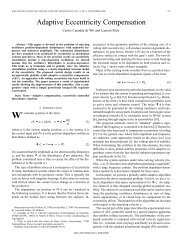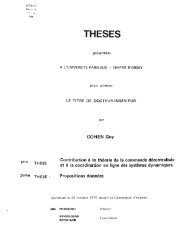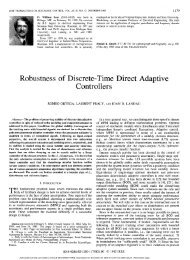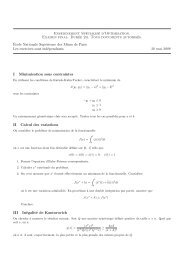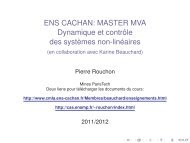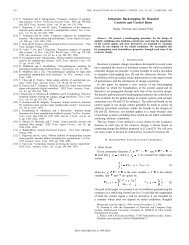Copyright © by SIAM. Unauthorized reproduction of this article is ...
Copyright © by SIAM. Unauthorized reproduction of this article is ...
Copyright © by SIAM. Unauthorized reproduction of this article is ...
You also want an ePaper? Increase the reach of your titles
YUMPU automatically turns print PDFs into web optimized ePapers that Google loves.
1828 V. ANDRIEU, L. PRALY, AND A. ASTOLFIConsequently the assumptions <strong>of</strong> Theorem 3.1 are sat<strong>is</strong>fied for i + 1 = n. We canapply it recursively up to i = 1, obtaining the vector field K 1 .As a result <strong>of</strong> <strong>th<strong>is</strong></strong> procedure we obtain a homogeneous in the bi-limit observer,which globally asymptotically observes the state <strong>of</strong> the system (3.1), and also thestate for its homogeneous approximations around the origin and at infinity. In otherwords, the origin <strong>is</strong> a globally asymptotically stable equilibrium <strong>of</strong> the systems(3.12) Ė 1 = S n E 1 + K 1 (e 1 ) , Ė 1 = S n E 1 + K 1,0 (e 1 ) , Ė 1 = S n E 1 + K 1,∞ (e 1 ) .Remark 3.2. Note that when 0 ≤ d 0 ≤ d ∞ , we have 1 ≤ r0,i+d0r 0,ii =1,...,n and we can replace the function q i in (3.10) <strong>by</strong> the simpler function≤ r∞,i+d∞r ∞,iforr 0,i +d 0rq i (s) = s 0,ir ∞,i +d∞+ sr ∞,i,which has been used already in [1].Example 3.3. Consider a chain <strong>of</strong> integrators <strong>of</strong> dimension two, with the followingweights and degrees:()(r 0 , d 0 ) = (2 − q, 1), q− 1 , (r ∞ , d ∞ ) =()(2 − p, 1), p− 1 .When q ≥ p (i.e., d 0 ≤ d ∞ ), <strong>by</strong> following the above recursive observer design weobtain two positive real numbers l 1 and l 2 such that the systemwith(3.13) q 2 (s) =˙ˆX 1 = ˆX 2 − q 1 (l 1 e 1 ) , ˙ˆX 2 = u − q 2 (l 2 q 1 (l 1 e 1 )) ,e 1 = ˆX 1 − y,{ 1q sq , |s| ≤ 1,1p sp + 1 q − 1 p , |s| ≥ 1, q 1 (s) ={(2 − q) s12−q , |s| ≤ 1,(2 − p)s 12−p + p − q, |s| ≥ 1,<strong>is</strong> a global observer for the system Ẋ 1 = X 2, Ẋ 2 = u, y = X 1. Furthermore, its homogeneousapproximations around the origin and at infinity are also global observersfor the same system.4. Recursive design <strong>of</strong> a homogeneous in the bi-limit state feedback.It <strong>is</strong> well known that the system (3.1) can be rendered homogeneous <strong>by</strong> using astabilizing homogeneous state feedback which can be designed <strong>by</strong> backstepping (see[21, 25, 19, 26, 33, 10], for instance). We show in <strong>th<strong>is</strong></strong> section that <strong>th<strong>is</strong></strong> property canbe extended to the case <strong>of</strong> homogeneity in the bi-limit. More prec<strong>is</strong>ely, we show thatthere ex<strong>is</strong>ts a homogeneous in the bi-limit function φ n such that the system (3.1) withu = φ n (X n ) <strong>is</strong> homogeneous in the bi-limit, with weights r 0 and r ∞ and degrees d 0and d ∞ . Furthermore, its origin and the origin <strong>of</strong> the approximating systems in the0-limit and in the ∞-limit are globally asymptotically stable equilibria.To design the state feedback we follow the approach <strong>of</strong> Praly and Mazenc [25]. To<strong>th<strong>is</strong></strong> end, consider the auxiliary system with state X i =(X 1,...,X i) in R i ,1≤ i




